When it comes to building a wood fence, choosing the right screws is crucial for durability and strength. In this guide, I will explore the different types of screws to use for wood fences and discuss their benefits and applications. By selecting the best screws for your wood fence project, you can ensure a long-lasting and secure installation.
Key Takeaways:
- Choosing the right screws is important for the durability and strength of your wood fence.
- Galvanized screws are popular for their durability and resistance to rust and corrosion.
- Stainless steel screws offer exceptional strength and corrosion resistance, making them ideal for humid areas.
- Ceramic or polymer-coated exterior screws provide enhanced resistance to moisture and UV rays while blending seamlessly with the wood.
- Selecting the appropriate screw size, composition, thread design, and head style is essential for a secure and long-lasting wood fence.
Types of Wood Fence Fasteners
When it comes to constructing a wood fence, choosing the right type of fastener is crucial. There are several options available, including nails, staples, and screws, each with its own advantages and recommended applications.
“Selecting the right type of fastener is essential for the successful construction of your wood fence.”
Nails: Nails are commonly used for attaching kickboards and pickets to the fence. They provide a cost-effective solution and are easy to install. However, nails may not offer the same level of strength and durability as other fasteners.
Staples: Staples are suitable for smaller components such as trims and pickets in picture frame fences. They are convenient to use and provide a secure attachment. However, staples may not be as strong as other fasteners and may be more prone to corrosion.
Screws: Screws are versatile and can be used for various applications in wood fences. They are particularly useful for gate hinges, picket attachments, and rail connections. Screws offer excellent holding power and can be easily tightened or adjusted if necessary. They are available in different materials and sizes to suit different wood types and fence components.
When selecting the best screws for your wood fence, consider factors such as the desired level of strength, corrosion resistance, and compatibility with the wood type. By choosing the appropriate fastener type, you can ensure a secure and durable wood fence installation.
| Fastener Type | Advantages | Ideal Applications |
|---|---|---|
| Nails | – Cost-effective | – Attaching kickboards and pickets |
| Staples | – Convenient | – Trims and pickets in picture frame fences |
| Screws | – Versatile – Excellent holding power – Easy to adjust |
– Gate hinges – Picket attachments – Rail connections |
Best Screws for Wood Fences
When it comes to building a wood fence, choosing the right screws is crucial for durability and strength. The best screws for a wood fence are those that offer exceptional durability, resistance to rust and corrosion, and enhanced resistance to moisture and UV rays. Let’s explore the top options:
1. Galvanized Screws
Galvanized screws are a popular choice for wood fences due to their high durability and resistance to rust and corrosion. The galvanization process involves coating the screws with a protective layer of zinc, making them suitable for outdoor applications.
2. Stainless Steel Screws
Stainless steel screws are another excellent option for wood fences, especially in areas with high humidity. They offer exceptional strength and corrosion resistance. The stainless steel composition ensures that the screws maintain their integrity even when exposed to moisture and environmental factors.
3. Ceramic or Polymer Coated Exterior Screws
Ceramic or polymer coated exterior screws are designed with enhanced resistance to moisture and UV rays, making them ideal for wood fences. These screws blend seamlessly with the wood, providing a clean and aesthetically pleasing finish.
When selecting the best screws for your wood fence, consider the specific requirements of your project. Factors such as the climate, wood type, and desired appearance will influence your choice. By investing in high-quality screws, you can ensure a secure and long-lasting installation that withstands the test of time.
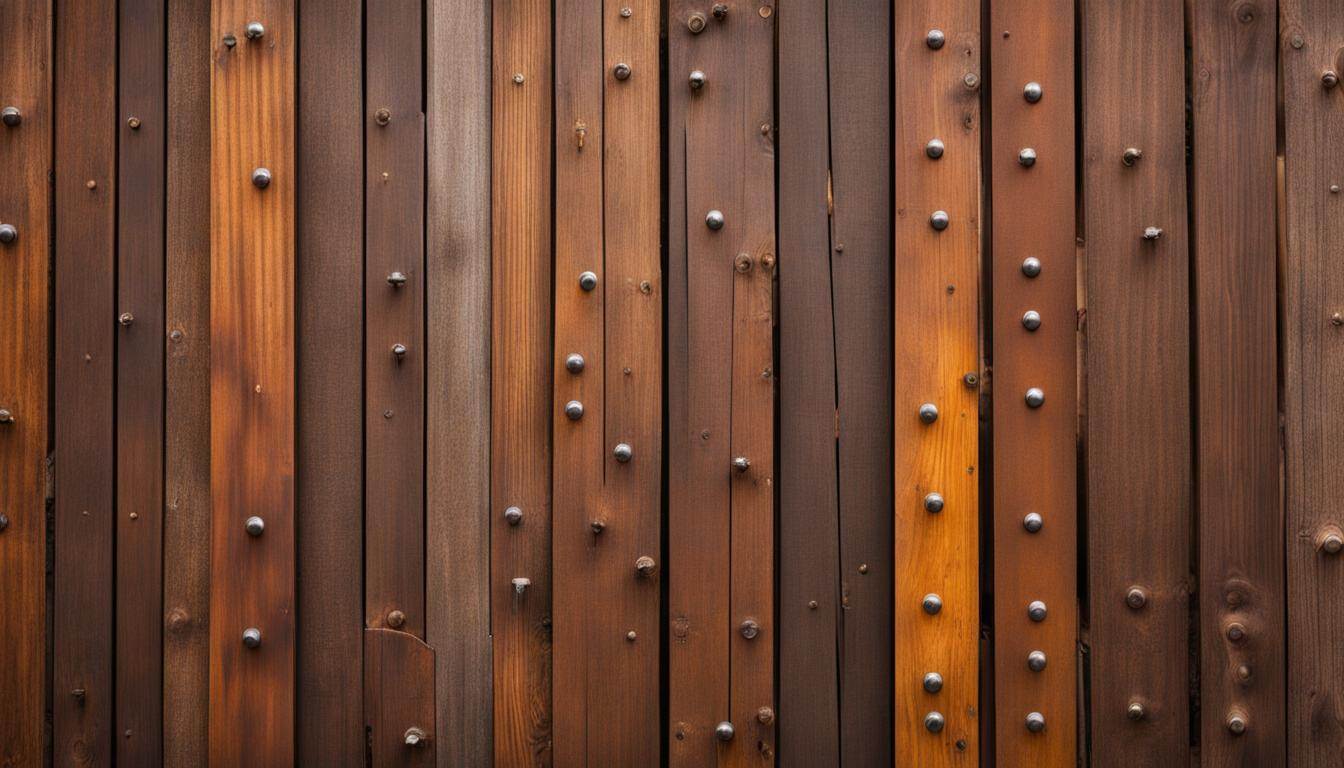
| Screw Type | Advantages | Recommended For |
|---|---|---|
| Galvanized Screws | Durable, rust and corrosion resistant | General wood fence applications |
| Stainless Steel Screws | Exceptional strength, corrosion resistance | Areas with high humidity |
| Ceramic or Polymer Coated Exterior Screws | Enhanced resistance to moisture and UV rays | Aesthetically pleasing finishes |
Remember to choose the appropriate screw size and length based on the thickness of the wood and the specific components you are attaching. Follow proper screw driving techniques to ensure secure connections. By selecting the best screws for your wood fence, you can achieve a secure and long-lasting installation.
Screw Sizes for Wood Fence
When it comes to selecting the right screws for your wood fence, considering the appropriate screw size is crucial. The size of the screws you choose will depend on the thickness of the wood and the specific components you are attaching.
For thin lattice panels or decorative trim boards, #6 and #7 screws may be suitable. If you are attaching 3/4-inch thick pickets and lattice, #8 screws are commonly used. For most 1-inch thick wood pieces such as vertical pickets and middle rails, #10 screws are recommended. When it comes to more heavy-duty elements like 4×4 posts and reinforcement beams, #12 diameter screws offer the necessary strength and stability.
Choosing the appropriate screw size ensures a secure and structurally sound wood fence, providing peace of mind for years to come.
| Wood Component | Screw Size |
|---|---|
| Thin lattice panels or decorative trim boards | #6 or #7 |
| 3/4-inch thick pickets and lattice | #8 |
| 1-inch thick wood pieces (vertical pickets, middle rails) | #10 |
| 4×4 posts and reinforcement beams | #12 |
Screw Thread Design for Wood Fence
The thread design of the screws you choose for your wood fence plays a crucial role in their holding strength. The right thread design ensures a secure connection that can withstand the elements and provide lasting durability.
Standard sharp-pointed wood screw threads are commonly used for wood fences as they provide a good grip on the wood fibers. These threads are versatile and suitable for various types of wood.
However, it’s important to consider the thickness and spacing of the threads based on the specific wood you’re working with. Fine-thread screws offer increased holding power in thicker or harder woods, ensuring a strong and secure connection. On the other hand, coarse-thread screws are engineered for use in softer pine wood, providing a reliable grip and stability.
By selecting the right thread design for your wood fence, you can ensure a secure connection that withstands the test of time and the outdoor elements.
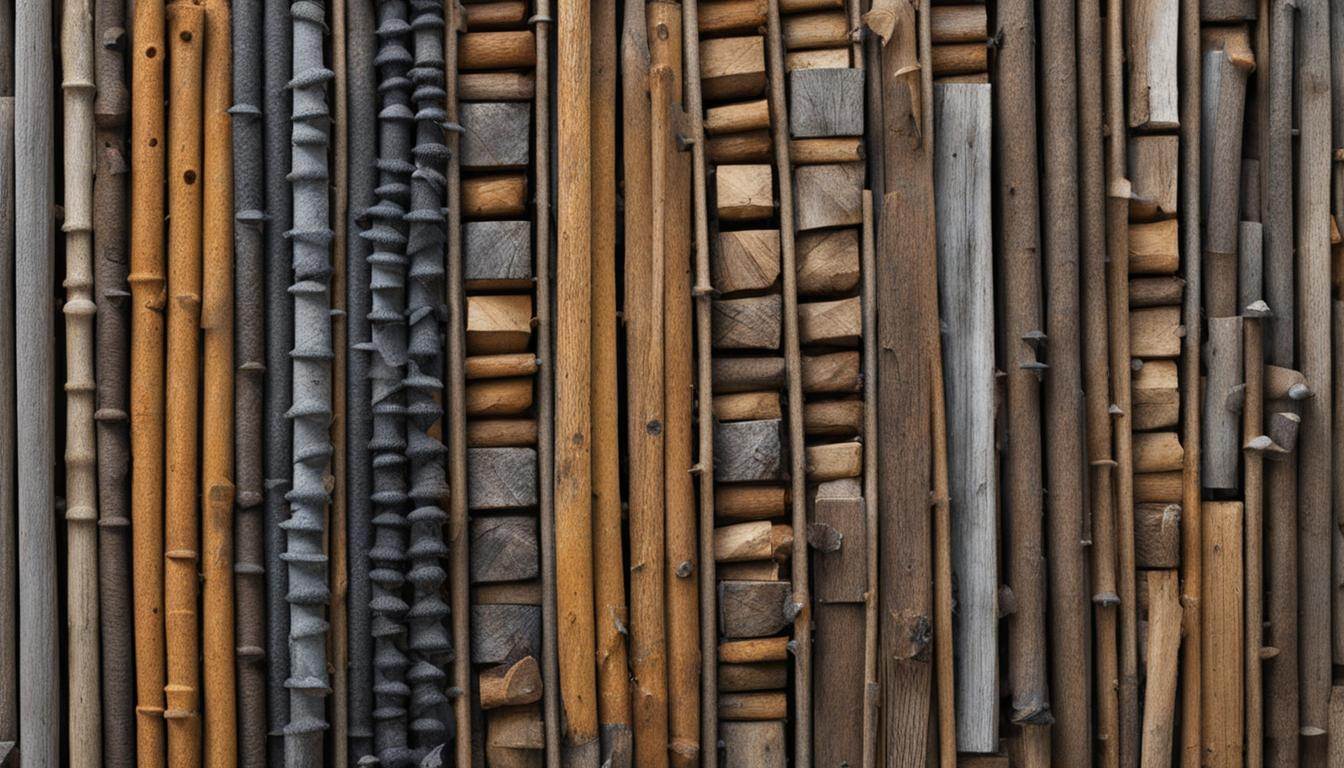
Key Takeaways:
- Select screws with standard sharp-pointed wood screw threads for a good grip on wood fibers.
- Consider fine-thread screws for thicker or harder woods to increase holding power.
- Choose coarse-thread screws for softer pine wood to ensure a reliable grip and stability.
Screw Composition for Wood Fence
The material composition of the screws is crucial when it comes to building a durable and long-lasting wood fence. Choosing the right screw composition ensures the screws can withstand outdoor elements and maintain their structural integrity over time.
There are three common types of screw compositions to consider:
- Standard Zinc or Nickel-Plated Screws: These screws offer budget-friendly corrosion protection. However, they may deteriorate over time, especially in outdoor environments with high levels of moisture and humidity.
- Stainless Steel Screws: Stainless steel screws provide enhanced corrosion resistance, making them an excellent choice for outdoor applications. They maintain their polished look and can withstand harsh conditions.
- Exterior Grade Ceramic or Polymer Coated Screws: These screws are specifically designed to resist moisture, UV rays, and other environmental factors. They offer superior protection and blend seamlessly with the wood, ensuring an aesthetically pleasing finish.
By selecting the best screw composition for your wood fence, you can ensure the longevity and durability of your installation.
Comparison of Screw Compositions
| Screw Composition | Corrosion Resistance | Longevity | Aesthetic Appeal |
|---|---|---|---|
| Standard Zinc or Nickel-Plated Screws | Basic corrosion protection | Moderate lifespan | Standard appearance |
| Stainless Steel Screws | Enhanced corrosion resistance | Long lifespan | Polished look |
| Exterior Grade Ceramic or Polymer Coated Screws | Exceptional corrosion resistance | Long lifespan | Seamless integration with wood |
The table above provides a comparison of the different screw compositions, highlighting their corrosion resistance, longevity, and aesthetic appeal. Consider these factors when choosing the best screws for your outdoor wood fence.
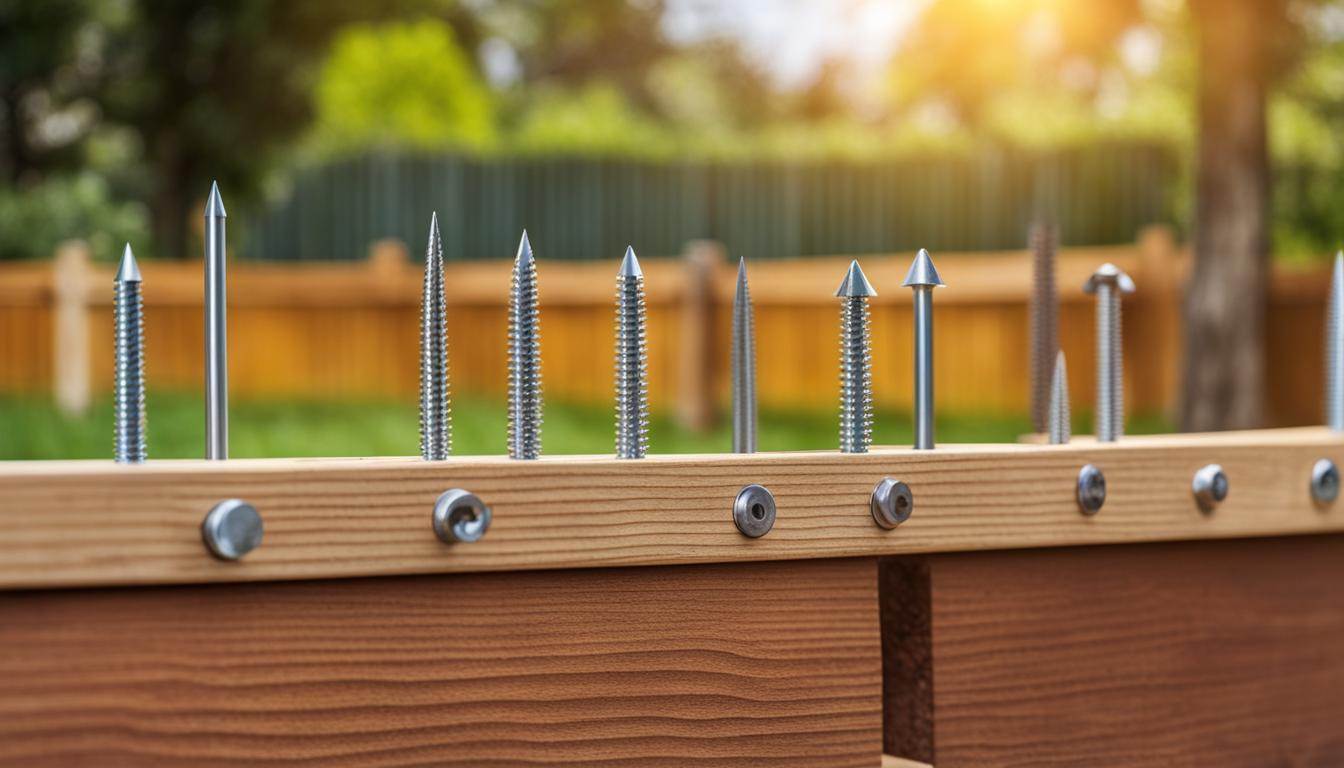
Screw Head Styles for Wood Fence
The style of the screw head impacts both the installation method and the overall appearance of your wood fence. Choosing the right screw head style is crucial to ensure easy installation and a visually appealing fence.
Slotted Drive Screws
| Advantages |
|---|
| Accept standard flat screwdrivers |
| Provide a classic look |
Phillips Drive Screws
| Advantages |
|---|
| Allow for manual or electric driving |
| Reduce the risk of overtightening |
Square Drive Screws
| Advantages |
|---|
| Offer enhanced torque transfer |
| Resist slipping |
Star/Torx Drive Screws
| Advantages |
|---|
| Allow for high torque driving with specialized bits |
Hex Drive Screws
| Advantages |
|---|
| Provide superior grip and torque transfer |
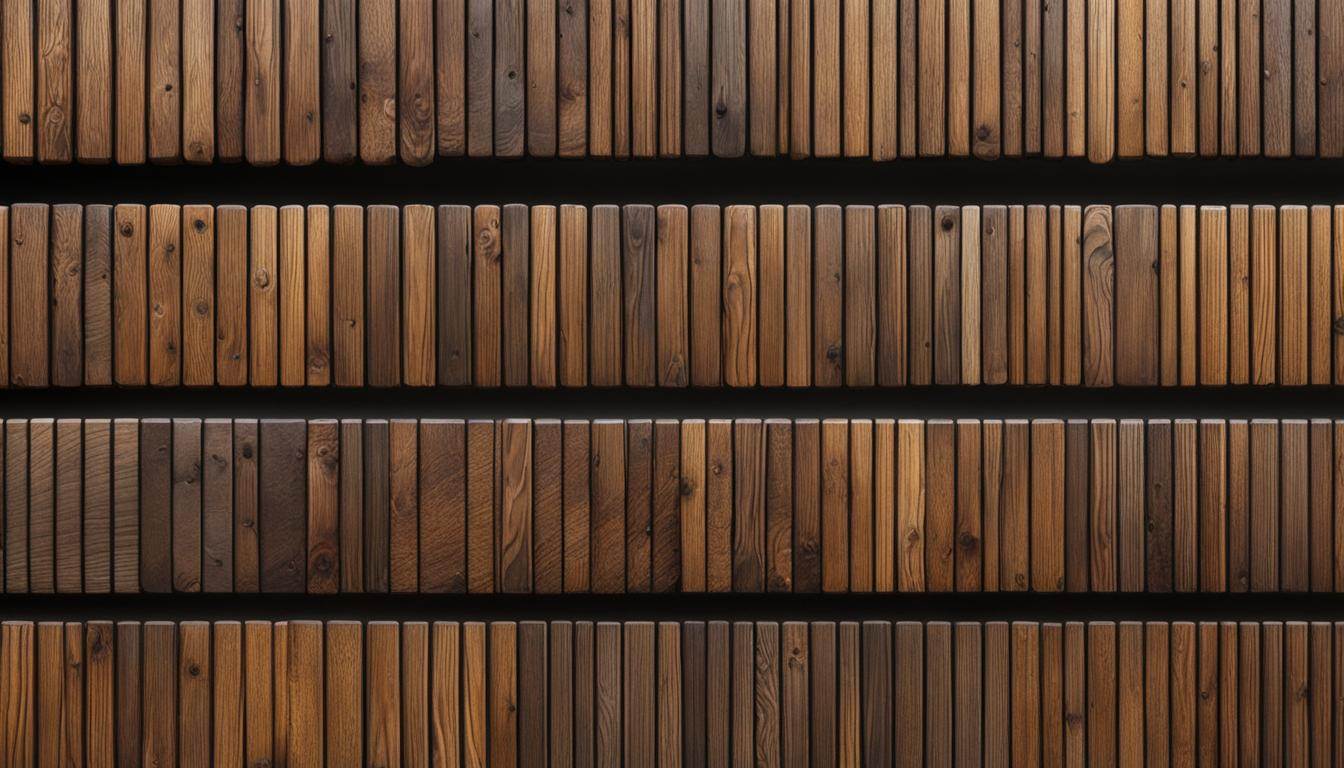
By selecting the appropriate screw head style, you can ensure easy installation and a fence that adds both function and visual appeal to your outdoor space.
Screw Lengths for Wood Fence
When it comes to building a wood fence, choosing the right screw length is crucial for ensuring a secure and durable installation. The length of the screws you use will depend on the thickness of the materials being joined.
For attaching pickets to rails: It is common to use 1 to 1 1/2-inch screws for this connection. These screws provide sufficient penetration while maintaining a secure attachment.
Joining vertical pickets to horizontal rails: For this type of connection, it is recommended to use 2-inch screws. These longer screws ensure a strong and reliable joint between the pickets and rails.
Rails or cross braces secured to posts: If you are securing rails or cross braces to the posts of your wood fence, 3-inch screws are typically recommended. These longer screws provide the necessary length to penetrate the wood and create a stable connection.
Structural connections between thick beams: For heavy-duty structural elements like thick beams, it is advisable to use 4-inch screws. These longer screws offer the necessary length and strength to securely fasten the beams and ensure the overall stability of the fence.
By choosing the appropriate screw length for each specific application, you can ensure proper penetration and a secure connection, resulting in a well-built and long-lasting wood fence.

Proper Screw Driving Techniques for Wood Fence
Proper screw driving techniques are crucial for creating solid connections in your wood fence. By following these techniques, you can ensure secure and long-lasting screw connections that will withstand the test of time.
To begin, set your drill/driver to a low-speed high-torque setting. This will help you avoid over-driving the screws, preventing damage to both the screws and the wood.
When working with harder woods, it is important to pre-drill pilot holes. This helps to prevent splitting and ensures a secure attachment. Take the time to carefully align the pilot hole with the screw’s path for a smooth insertion.
“Position screws perpendicular to the wood face for increased grip.”
Positioning the screws perpendicular to the wood face maximizes their grip on the wood fibers, providing a stronger connection. This technique distributes the load evenly and minimizes the risk of the screws loosening over time.
“Stagger the placement of multiple screws to prevent wood splitting.” When attaching long pieces of wood, consider staggering the placement of multiple screws. This technique helps distribute the load and reduces the risk of splitting the wood. It also adds stability and reinforces the connection.
For dense woods that pose a challenge when driving screws, consider using soap on the screw threads. This reduces friction and makes it easier to drive the screws into the wood. Apply a small amount of soap to the threads before inserting the screw.
By employing these proper screw driving techniques, you can ensure that your wood fence is securely fastened and built to last. Take the time to follow these guidelines, and you will be rewarded with a fence that provides both functionality and aesthetic appeal.
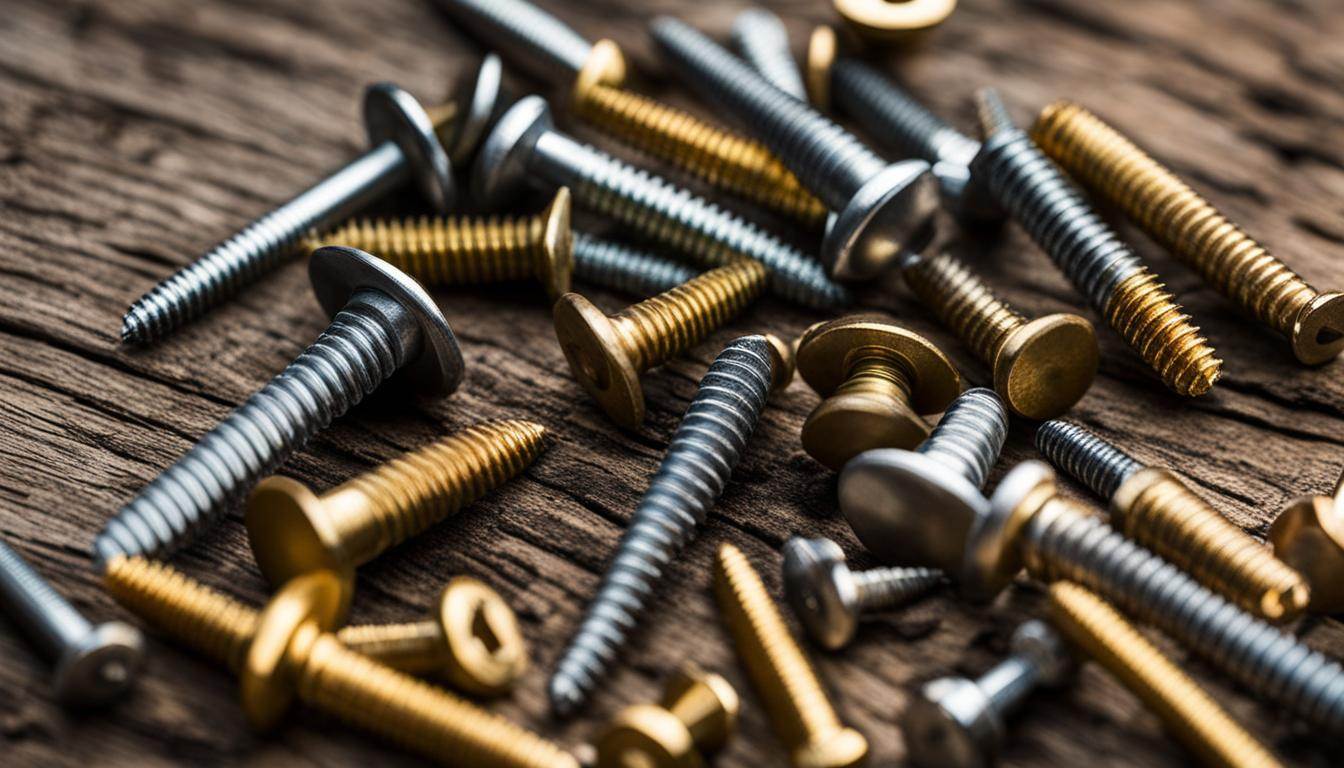
Screw Driving Techniques for Wood Fence – Summary
- Set your drill/driver to a low-speed high-torque setting to avoid over-driving the screws.
- Pre-drill pilot holes for harder woods to prevent splitting.
- Position screws perpendicular to the wood face for increased grip.
- Stagger the placement of multiple screws to prevent wood splitting.
- Consider using soap on screw threads to reduce friction in dense woods.
Alternative Fasteners for Wood Fence Assembly
While screws are the most commonly used fasteners for wood fences, there are alternative options available. Nails and bolts offer distinct advantages in certain applications, providing flexibility and strength for specific construction needs.
Nails
Nails are a traditional and cost-effective method for fastening wood fences. They are suitable for attaching pickets, trims, and kickboards. Nails come in various sizes and styles, including common nails, box nails, and ring shank nails. The right nail should be selected based on its gripping power and compatibility with the wood type.
Bolts
Bolts offer ultra-high strength and are commonly used for structural joints in wood fences. They provide added security and stability, especially for heavy-duty connections. Bolts typically require pre-drilling and are available in various diameters, lengths, and head styles. When using bolts, it’s important to consider the specific requirements of the fence design and select the appropriate bolt type for secure fastening.
Understanding the alternatives to screws can help you choose the best fastener for your wood fence assembly. Consider the application, desired strength, and overall durability when deciding between nails, bolts, and screws. Each option has its own advantages, and the right choice will depend on the specific requirements of your fence project.

Conclusion
Choosing the right screws for your wood fence is crucial in ensuring its durability, strength, and longevity. By carefully considering factors such as the type, size, thread design, composition, and length of the screws, you can make an informed decision that will lead to a successful fence installation.
In addition to selecting the appropriate screws, it is important to follow proper screw driving techniques to ensure secure connections. This includes setting your drill/driver to the correct speed, pre-drilling pilot holes for harder woods, and positioning the screws perpendicular to the wood face for better grip.
While screws are the most common choice for wood fences, it’s worth exploring alternative fasteners such as nails and bolts for specific applications. Nails can be a cost-effective option, while bolts offer exceptional strength for structural joints. Consider the requirements of your fence assembly to determine the best fastener for your needs.
By making informed decisions in choosing the right screws, following proper installation techniques, and considering alternative fasteners when necessary, you can ensure a wood fence that not only stands the test of time but also provides the durability and security you desire.
FAQ
What are the different types of wood fence fasteners?
The different types of wood fence fasteners include nails, staples, and screws. Each type has its own advantages and ideal applications.
What are the best screws for wood fences?
The best screws for wood fences are galvanized screws, stainless steel screws, and ceramic or polymer-coated exterior screws. Each type offers durability and resistance to rust and corrosion.
What screw sizes should I use for a wood fence?
The screw sizes you should use for a wood fence depend on the thickness of the wood and the specific components you are attaching. Common screw sizes range from #6 for thin lattice panels to #12 for heavy-duty elements like 4×4 posts and reinforcement beams.
What is the importance of screw thread design for a wood fence?
The screw thread design plays a crucial role in the holding strength of the fence. Standard sharp-pointed wood screw threads are commonly used, but the thickness and spacing can vary for different applications and types of wood.
What is the best screw composition for a wood fence?
The best screw composition for a wood fence depends on your specific needs. Standard zinc or nickel-plated screws offer budget-friendly corrosion protection, while stainless steel screws provide enhanced corrosion resistance. Exterior-grade ceramic or polymer-coated screws offer protection against moisture, UV rays, and environmental factors.
What are the different screw head styles for a wood fence?
The different screw head styles for a wood fence include slotted drive, Phillips drive, square drive, star/Torx drive, and hex drive. Each style offers different installation methods and affects the overall appearance of the fence.
What screw lengths should I use for a wood fence?
The screw lengths you should use for a wood fence depend on the thickness of the materials being joined. For attaching pickets to rails, 1 to 1 1/2-inch screws are commonly used. Joining vertical pickets to horizontal rails typically requires 2-inch screws, while connections between thick beams may need 4-inch screws.
What are the proper screw driving techniques for a wood fence?
The proper screw-driving techniques for a wood fence include setting your drill/driver to a low-speed high-torque setting, pre-drilling pilot holes for harder woods, positioning screws perpendicular to the wood face, staggering the placement of multiple screws, and using soap on screw threads to reduce friction in dense woods.
Are there alternative fasteners for wood fence assembly?
Yes, there are alternative fasteners for wood fence assembly. Nails offer a traditional and cost-effective method, while bolts provide ultra-high strength for structural joints. Nails should be selected based on their gripping power and compatibility with the wood type, while bolts require pre-drilling and are often used for heavy-duty connections.
What are the key considerations when choosing screws for a wood fence?
When choosing screws for a wood fence, key considerations include the type, size, thread design, composition, length, and head style of the screws. Each of these factors plays a role in ensuring durability, strength, and longevity for the wood fence.

